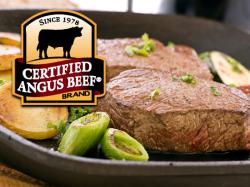Certified Beef Brands: Historical Sketch Shows Dynamite Comes In Small Packages
April 27, 2011 | 3 min to read

What began as an idea to create specifications for beef with a breed connection has sparked the interest of many over the years to create their own branded programs. The founding brand remains at the top, but the proliferation of others has arguably made the entire beef industry more consumer driven.
“The Certified Angus Beef ® (CAB®) brand started in 1978 and, after a few years, others saw the success of that kind of program,” says David O’Diam, CAB brand extension manager. “Many of these brands have taken advantage of the fact that USDA will certify a program, giving validity to their brand in terms of the specifications they set forth.”
In the late 1980s, USDA began approving more programs under various schedules, many of which were not involved with Angus but focused on other beef characteristics.
Larry Meadows, chief of the Meat Grading and Certification Branch at USDA, explains that creating a program means specifying quality grade and yield grade requirements. Upon applying to USDA’s Standardization Branch, the document is sent to the Food Safety and Inspection Service and other USDA staff. Once all parties agree, the program is approved and officially published.
As of December 2001, 30 of the 41 USDA Certified Programs were Angus focused. That year, 20 programs had specifications of premium Choice or Prime, and 12 of those were Angus focused, but so were nine of the 12 Select programs.
By 2005, the total number of programs had increased to 63 while the number of Angus programs rose to 46.
And as of February of this year, there are 111 programs total with 76 focusing on the Angus breed, but only 29 of those were in effect in 2005. Twenty-four of the 43 premium Choice and Prime programs are Angus focused, but so are five of the six Standard or lower quality programs. “That shows us Angus does not necessarily equal high quality,” O’Diam says.
Through the years, the numbers fluctuate as new programs are added and others are removed.
“A lot of programs don’t survive,” Meadows says. Groups may have good ideas, “but their brands can’t compete in today’s very competitive marketplace.”
Cargill’s Sterling Silver program, not connected to any breed, was the second schedule approved by USDA and is still in existence. Though it has the same marbling criteria as CAB, it accepts A and B maturity cattle, whereas CAB accepts only A maturity.
O’Diam notes that almost three-fourths of the programs are Angus connected: “That shows the power of the breed.”
Meadows elaborates. “A lot of retailers are requesting Angus because the Angus breed is viewed very favorably by consumers. Firms look at CAB and see their market share and want to create an Angus-based program for their customers.”
About 80% of the product certified in the upper two-thirds of Choice goes to the CAB brand, explains Meadows.
When CAB made changes to its specifications in 2007, other programs converted the same way to fit the sorting process at packing plants. If CAB and other brands have identical requirements, then any product not sold through CAB can be sold through those others as a fallback.
“Packers are very, very good businessmen,” O’Diam says. “And ultimately, if it doesn’t make them more money in a CAB box, they aren’t going to put it in that box. We have to continue to be more relevant than any other brand, and in the packer’s mind that means not only marketability but ultimately profitability.”
Being the most recognized brand of beef in the country took more than product specifications, he adds, noting that all branded product is tracked from packer to consumer to ensure positive eating experiences.
“All of the 120 people that work for this brand from Ohio to Kansas and all across the U.S. wake up each morning thinking about how to build on that,” O’Diam says.
CAB presses on with quality and profitability even in a recession. “I think it shows the value of the brand that it continues to grow when most people are uncertain about consumer demand,” he says.
Source: Certified Angus Beef® Brand
